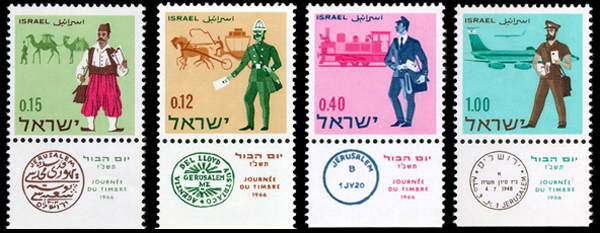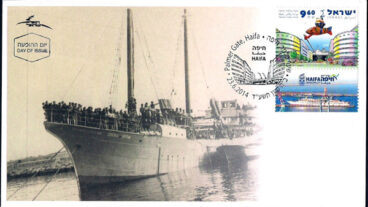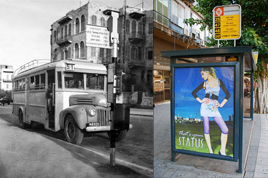The Israel Postal Company recently celebrated its history with a souvenir sheet depicting the progression of postal vehicles in the Land of Israel. “Follow the movement of letters and parcels with this interesting souvenir sheet illustrating different postal vehicles,” is how the Postal Company describes the set but there’s more than just package delivery here. The history of mail delivery is as complicated as the region itself.
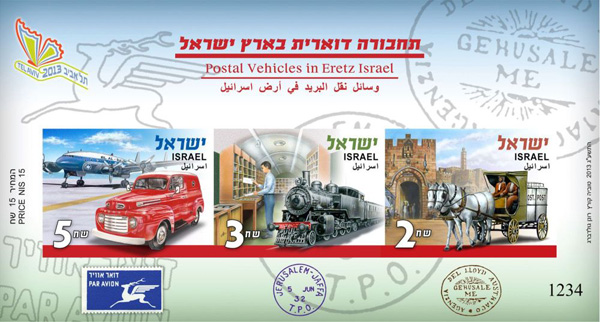 The first of the three stamps in the series features an Austrian Post carriage against the background of the Jaffa Gate in Jerusalem. A postmark from the Austrian Lloyd Agency, which operated in Jerusalem, appears below the stamp.
The first of the three stamps in the series features an Austrian Post carriage against the background of the Jaffa Gate in Jerusalem. A postmark from the Austrian Lloyd Agency, which operated in Jerusalem, appears below the stamp.
The second stamp depicts the inside of a mail sorting train car, operated by the British Mandatory Railway in Eretz Israel. A Traveling Post Office (T.P.O.) postmark is featured below the stamp.
The third stamp features a red automobile that served the Israel Post in the early years of the State. A Constellation C49 cargo plane used for transporting mail in the 1950’s appears beside it and an Israel Post Airmail label is featured below the stamp.
A finely preserved “Red Automobile” is on display at the Alexander Museum of Postal History and Philately at the Eretz Israel Museum in Tel Aviv.
 This isn’t the first time that the Postal Company has recognized its history in philatelic form. In December of 1967 the first nation-wide Stamp day was held in Israel. On this occasion a series of four stamps was issued depicting local postmen from different time periods.
This isn’t the first time that the Postal Company has recognized its history in philatelic form. In December of 1967 the first nation-wide Stamp day was held in Israel. On this occasion a series of four stamps was issued depicting local postmen from different time periods.
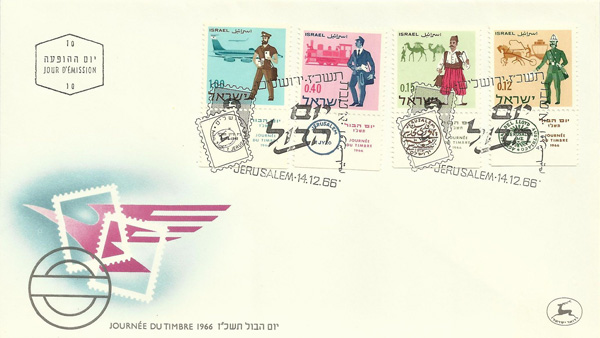 During the Ottoman Empire, the first postal offices in Eretz Israel were established by Europeans on the strength of Capitulation Treaties between the Ottoman central government and individual European Powers.
During the Ottoman Empire, the first postal offices in Eretz Israel were established by Europeans on the strength of Capitulation Treaties between the Ottoman central government and individual European Powers.
According to the Israel Postal Company, “Until the mid-19th century, Eretz Israel was a remote province in the outlying regions of the Ottoman Empire and residents had no organized mail service whatsoever.”
“The first post office in Eretz Israel was probably the French post office in Jaffa (1852) with a collection point for letters at the French Consulate in Jerusalem. The first real post office in the Capital was most likely the Austrian one (about 1854). In addition to Jerusalem and Jaffa, there were also Capitulation post offices in Haifa. Attempts to establish branch offices in smaller places were short-lived or, at best, unrecognized. All foreign post offices were closed upon Turkey’s entry into the First World War (30/9 – 1/10, 1914).”
“The most efficient and organized service was provided by the Austrian Post, which was the first to use a special carriage to transport letters and packages within Eretz Israel. Just six hours after the Austrian postal ship docked at Jaffa Port, patrons could receive their mail at the Austrian Post branch located by the Jaffa Gate in Jerusalem.”
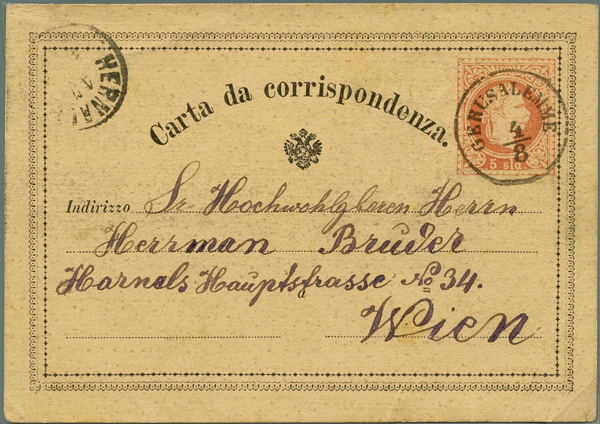 The Turkish post-offices closed with the conquest of Eretz Israel by General Allenby (1917/18).
The Turkish post-offices closed with the conquest of Eretz Israel by General Allenby (1917/18).
“At the end of World War I, Palestine was in the hands of the British army. With the return of civilian life the existing army post offices were opened to the public and, after the establishment of a civilian administration, the post offices too came under civil administration. Parallel with the development of the country, the postal system expanded. In 1933 there were 40 post offices or agencies. At the end of the British Mandate, the number already reached 100 (not counting town branches).
“When the railroad line between Jaffa and Jerusalem was completed in 1892, the Ottoman Post (which had sole rights to use the line), improved its speed and reliability by transporting mail via train. Additional rail lines constructed in Eretz Israel were also used for transporting mail.”
“During the British Mandate the use of trains for transporting mail increased significantly. Some trains were equipped with a special postal car that collected mail at stops along the route. Postal workers sorted the mail as the train continued on its way, thus greatly decreasing the time it took for mail to reach its destination.”
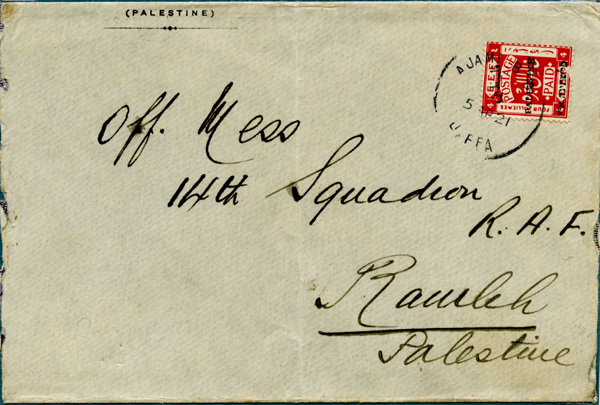 Following the establishment of the State of Israel in May 1948, there was an interim period during which stamps issued by the Jewish National Fund were used until a national postal service was organized. You can read more about these stamps in a previous posting.
Following the establishment of the State of Israel in May 1948, there was an interim period during which stamps issued by the Jewish National Fund were used until a national postal service was organized. You can read more about these stamps in a previous posting.
“The Israel Post began using special vehicles, commonly referred to as ‘The Red Automobile’, which frequented each town daily and served as mobile post offices.
“The Israel Post also utilized the services provided by sea and air transport companies to maintain postal ties between Israel and other countries around the world. The service provided by El Al, Israel’s national airline, for transporting postal items overseas, is especially noteworthy.”
For more about the history of postal delivery in the Land of Israel, pay a visit to the Alexander Museum of Postal History & Philately. This collection is composed of unique philatelic items — hundreds of which have been scanned and archived online — and covers 600 years of the history of Eretz Israel. It represents important chapters dealing with geo-political and socio-economic aspects: the pre-philatelist era, the Turkish post, foreign post offices, World War I, the development of Zionism and the settlement in Eretz Israel, the British Mandate, the War of Independence, and the establishment of the State of Israel.
The Museum’s Alfred Goldschmidt Collection traces the history of air mail delivery to and from Eretz-Israel, and is known to be the largest of its kind.
